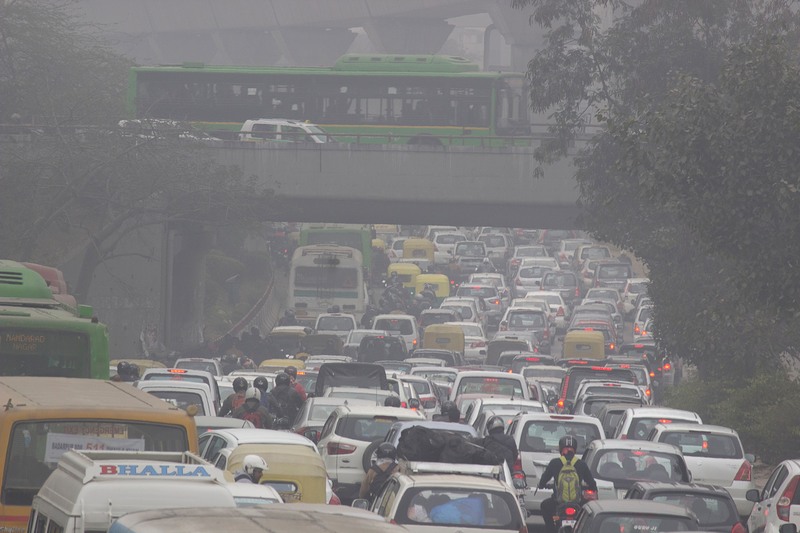
New Delhi: The 2021 World Air Quality Report for the fourth consecutive year finds New Delhi as the most polluted capital city (and fourth most polluted city) in the World followed by Dhaka in Bangladesh, N’Djamena in Chad, Dushanbe in Tajikistan and Muscat in Oman. New Delhi saw a 14.6% increase in PM2.5 concentrations in 2021 with levels rising to 96.4 μg/m3 from 84 μg/m3 in 2020.
India also continues to feature prominently among the most polluted cities – with 35 of the top 50 most polluted cities being in India. While India’s annual average PM2.5 levels reached 58.1 μg/m3 in 2021, ending a three-year trend of improving air quality. India’s annual PM2.5 averages have now returned to pre-quarantine concentrations as measured in 2019.
Alarmingly, in 2021, NONE of the India cities met the prescribed World Health Organization (WHO) standards of 5 μg/m3. 48% of India’s cities exceeded 50 μg/m3 or more than 10 times the WHO guidelines.
Commenting on the IQAir recent data, Avinash Chanchal, Campaign Manager at Greenpeace India says: “The report is a wake up call to governments and corporations. It is once again highlighting that people are breathing dangerously polluted air. Vehicular emissions are one of the major contributors to urban PM2.5 concentrations. With annual vehicle sales in India expected to increase, it is certainly going to impact air quality if corrective measures are not taken in time.”
“Air pollution has a massive impact on human health and is a major indicator of the accelerating climate catastrophe. The good thing is we don’t need to invest in science to find the solutions to the air pollution crisis. We know the solution, and it is readily accessible. PM air pollution is produced by burning of fuels which is a major contributor to the climate crisis. It is high time that governments promote renewable energy for transportation and build infrastructure that encourages cycling, public transport and pedestrians,” added Chachal.
It is noteworthy that in 2019 India’s Ministry of Environment, Forest and Climate Change (MoEF&CC) enacted the National Clean Air Program (NCAP). The plan seeks to reduce PM concentrations by 20% to 30% by 2024 in all identified non-attainment cities, increase air quality monitoring, and implement a city, regional, and state-specific clean air action plan as well as conduct source apportionment studies. However, the lockdowns, restrictions, and resulting economic downturn due to the COVID-19 pandemic have made it difficult to determine the plan’s impact based on air pollution levels alone. A recent report found that apart from city-specific action plans, no other plans have been formulated under NCAP prescribed timelines. This indicates the slow progress of NCAP which is a crucial program to achieve India’s clean air dream. Additionally, there is little information about the activities related to the NCAP, making it difficult to dispel the public’s dissatisfaction with the slow progress under the program.On the global front, the 2021 World Air Quality Report finds that only three percent of cities and no single country met the latest World Health Organization’s (WHO) PM2.5 annual air quality guidelines.
The report analyzes PM2.5 air pollution measurements from air monitoring stations in 6,475 cities in 117 countries, regions and territories.
“It is a shocking fact that no major city or country is providing safe and healthy air to their citizens according to the latest World Health Organization air quality guidelines,” said Frank Hammes, CEO of IQAir. “This report underscores just how much work remains to be done to ensure that everyone has safe, clean and healthy air to breathe. The time for action is now.”IQAir’s 2021 World Air Quality Report is the first major global air quality report based on updated annual WHO air quality guidelines for PM2.5. The new guidelines were released in September 2021 and cut existing annual PM2.5 guideline values from 10 µg/m3 to 5 µg/m3.
Fine particle pollution, known as PM2.5, is commonly accepted to be the most harmful, widely-monitored air pollutant and has been found to be a major contributing factor to health effects such as asthma, stroke, heart and lung diseases. PM2.5 leads to millions of premature deaths every year.
About IQAir
IQAir is a Swiss-based air quality technology company that empowers individuals, organizations, and communities to breathe cleaner air through information, collaboration and technology solutions. IQAir provides affordable air quality monitoring and data solutions to governments, NGOs, educational institutions, corporations and individuals in over 100 countries.
For any other additional information:
Avinash Chanchal
+91-8882153664
[email protected]
Rohin Kumar
+91-9013971997
[email protected]
Nischita Verrendra
+91-9845828096
[email protected]
Reference:
Brook JR et al. (2007). Assessing sources of PM2.5 in cities influenced by regional trans- port. Journal of Toxicology and Environmental Health. DOI:10.1080/15287390600883000 https://www.tandfonline.com/doi/ abs/10.1080/15287390600883000
